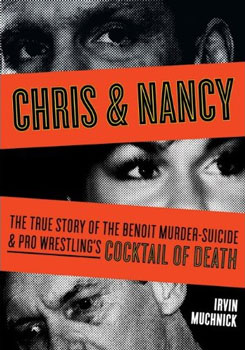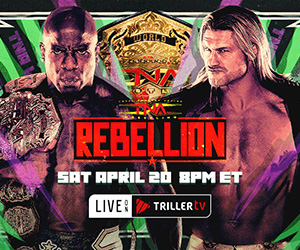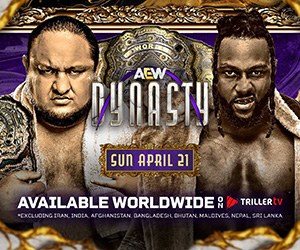By DAVID BIXENSPAN – For SlamWrestling.net
I wasn’t sure what to expect from Chris & Nancy, Irvin Muchnick’s new book about the Chris Benoit murder-suicide and everything surrounding it. I have been a fan of Muchnick’s wrestling writing (collected in Wrestling Babylon) for years, but I was unsure of the direction he was taking based on his blog posts related to his research for the book. He seemed to be making conspiracies out of nothing at points, sometimes based on misstatements and seemingly pulling them out of thin air at other points.

That said, there were also some real gems on the blog. That, along with the fact that he was going to meticulously research everything, made me look forward to the book, but with some reservations. In the end, the book came out pretty well and it’s an important bit of wrestling history, but its flaws are frustrating and make the book hard to read in parts.
The initial summary of the murders in June of 2007 and the initial police response is well-written, and brings up a previously unmentioned discrepancy between the causes of death for Daniel on the autopsy report and the death certificate (“cervical compression” and “suffocation” respectively). This is curious, to say the least. This veers off from the facts into over-analyzing the content of the 911 calls. Dennis Fagan of security firm Andrews International made the call and said “I run security for World Wrestling” before giving the details, including the erroneous statement that the text messages sent by Chris Benoit to Chavo Guerrero Jr. and Scott Armstrong were sent early that morning when they were actually sent 24 hours earlier. Muchnick gives too much credence to the possibility that this was some sort of attempt at misdirection by Fagan given the fact that the correct time of the messages would be readily apparent, on top of the fact that Fagan didn’t even seem to know the proper name of the company that he was working for.
In a later chapter, Muchnick goes over a more questionable issue about the timing of the texts: Guerrero’s conflicting stories about when he received them. At one point, Guerrero said he was woken up by the new message notification sound on his phone early Sunday morning, and at another, he claimed that he had cellular reception problems and didn’t get the messages until Monday morning. The speculation about Fagan sets a tone that persists throughout the rest of the book.The chapter that serves as a brief biography for Chris and Nancy would be perfectly acceptable, except for a shocking omission. While Muchnick does mention that their onscreen coupling booked by Nancy’s then-husband Kevin Sullivan led to their real-life one, he leaves out the most important detail. Sullivan ordered them to travel together and canoodle in public in an attempt to fool the other wrestlers and generate buzz in the newsletters. It was Sullivan’s second attempt at such a “shoot angle” after his feud with Brian Pillman blew up in his face when Pillman conned Eric Bischoff into giving him a real release from his contract so he could go to the WWF. The wrestlers weren’t fooled this time and the only newsletter buzz was about how much it annoyed them. While other onscreen couples in wrestling have gotten together in real life without being forced to grope each other in hotel bars, the attempt at an off-screen con has always been cited as a major force in Chris and Nancy getting together for real.
Matthew Randazzo V’s Ring of Hell, which focused mainly on Chris’s career and surroundings as opposed to the murder-suicide and fallout, paints a much clearer picture of the Kevin/Nancy marriage and Sullivan “booking his own divorce” than Muchnick did, in what is probably that book’s strongest chapter. Muchnick’s exclusion of key details is a reminder that while his wrestling writing is largely about things that only hardcore fans care about, he’s not a hardcore fan himself, someone who would realize when things like the above are missing.In another odd error that shouldn’t have been printed, Mike Durham (Johnny Grunge) and his wife Penny are referred to as “Dunham” throughout the book. Muchnick seems to be under the false impression that Chris regularly volunteered at benefit shows for the families of deceased wrestlers on his days off (he wrestled on Les Thatcher’s annual Pillman Memorial shows from ’98-’00, missing the last show in ’01 due to his neck injury but to the best of my knowledge, that was it) as if they occurred fairly often. He furthered the false rumor that Steven/William Regal was re-hired by WWE due to his performance in his match with Chris at the ’00 Pillman Memorial when he had already been under contract and in developmental as a wrestler and trainer for months with a promised starting date for the main roster.
Everything about the late period of Chris and Nancy’s marriage, the week of the murders, and the immediate fallout is excellent and very well-researched. Numerous text messages from Nancy to Chris (some previously published in the Wrestling Observer Newsletter, some not) are included, in addition to an increasingly sexist (and, given what happened, disturbing) exchange of texts between Chris and Gregory Helms, which paint a very vivid picture of the mess that their relationship had devolved into. These chapters are a strong point of the book, tightly written and focused without the conjecture that’s floating around at other points. There’s even an excerpt from Dave “Fit” Finlay’s agent report for the WWE house show in Beaumont, TX that Chris missed after committing the murders but before committing suicide (the full text of the report is included on the companion DVD-ROM of source material that Muchnick is selling separately).
Muchnick seems to come as close as he can short of a confession to definitively proving that WWE higher-ups knew that Chris was the killer hours before the tribute show went on the air and doesn’t speculate as to why they went through with it. He does mention that there were those with hopes and/or suspicions within the company that Nancy was the killer, which explains why she, a long-time valet who they have plenty of footage of, was relatively invisible (until Jerry Lawler made sure to remind the viewers) on what was billed as a tribute to her, as well.The over-analysis returns when a chapter is devoted to the text messages and the two different timelines released by WWE, which contain conflicting information as to whether Chris’s flight to Texas was re-booked for Saturday night or Sunday morning. While it is absolutely worth mentioning that there are holes in WWE’s story, and the delay by Guerrero and Armstrong in reporting the texts to WWE is bizarre at best and deeply troubling at worst, this section feels like too much: Too much of the same thing and too much speculation. There’s also a strange error where he implies the existence of two tribute videos recorded for Chris Benoit by Guerrero (one for TV, one for WWE.com).
These late chapters seem to alternate between more of the overly speculative analysis and solid reporting. The coverage of what the police district attorney’s office and sheriff’s department bungled is right on the money, and Muchnick has an interesting perspective on the Fragile X reports. From District Attorney Scott Ballard’s comments (later retracted) to the press about Daniel being “almost dwarfed” and the alleged needle marks on his body (not mentioned in the autopsy report) to the sheriff not bothering to subpoena Verizon Wireless for Chris and Nancy’s voicemail messages to not searching the house thoroughly and letting Nancy’s family move in quickly, it’s all here, and it’s all dissected in infuriating detail.
And then there was Wikipedia. The edit to Chris’s bio on Wikipedia that seemingly announced the death of Nancy before the bodies were found was quickly dismissed as an eerie coincidence by wrestling fans, and after milking it for a few days, the media did the same. Not Muchnick, although in fairness, he had a good reason since he had to threaten to sue to get the complete video of the police interview with Matthew Greenberg, who made the initial edit (the public Benoit case file contained an incomplete copy). Even though it had to be a coincidence, the police were right to question Greenberg, but Muchnick felt that they didn’t do enough. Greenberg’s previous Wikipedia edits had all been vandalism, except for when he removed racial slurs from Guerrero’s entry, and Muchnick is insistent that the police should have questioned him about any connection to Guerrero due to the anomaly. While the police in Stamford, CT (home of WWE, which made the whole situation weirder) probably could have done a better job, this is a case of Muchnick searching for a conspiracy where one didn’t exist.As far as newsworthy material, Chapter 10 is the highlight of the book. It reveals that minutes after the cops stupidly let neighbor Holly Schrepfer enter the house to corral the Benoit family’s guard dogs, she encountered Dave Taylor and his wife walking down the block with a plate of cold cuts, almost as if they were going to a wake. There’s nothing in the case file about this and the information was revealed in when the lawyers representing Michael Benoit (Chris’s father) interviewed Schrepfer. Dave Taylor denied to Muchnick that he was there in phone interviews, claiming that he was in Texas for the WWE house shows and pay per view event even though he wasn’t booked. No WWE records seem to indicate that he was there and wrestlers have refuted the idea that someone would fly to a tour of shows where he wasn’t booked. When Muchnick first implied that WWE sent someone to the Benoit house on his blog, he seemed to be citing the dogs escaping the area where Chris put them, and this seemed premature, but this evidence certainly vindicates him in that respect.
Before the final chapters about Dr. Phil Astin III and the congressional inquiry that went nowhere (both are solid, but if you’re familiar with the situation, there’s nothing new), Muchnick goes over the media coverage of the tragedy. The review of the mainstream coverage is relatively fair and accurate, a solid summary of the most notable parts.
The second half of the chapter goes over Muchnick’s relationship with Dave Meltzer of the Wrestling Observer Newsletter throughout the course of his investigative efforts. Muchnick felt that their relationship deteriorated as he expressed his beliefs that Meltzer wasn’t reporting enough about the criminal investigation itself (focusing more on the spotlight that was shone on wrestler deaths and drug abuse) and withheld certain stories from the public to protect sources. There seems to be an implication that outing then head of WWE Canada Carl DeMarco as Meltzer’s source for WWE executive knowledge of Chris being the killer before the tribute shows was an issue of concern. Muchnick is not the first to accuse Meltzer of withholding stories, but is probably the most high-profile.There were similar sentiments by some fans online after stories about events from several months earlier were broken by Muchnick (on his blog) and Matthew Randazzo V (in Ring of Hell) and Meltzer confirmed long-term knowledge of them after those accounts were published. Earlier in the book, Muchnick also states as a fact that Chris Benoit and Chavo Guerrero Jr. flushed Eddie Guerrero’s supply of the anabolic steroid stanozolol (branded as Winstrol) before calling 911. Given that Chavo is the only living person who was in the room and he refused to talk to Muchnick, it certainly makes one think about where the information came from.
The book closes with an appendix about people that he spoke to while researching for the book. These passages include stories about the dissolution of his relationships with some of them over various ideological issues.While the negatives are there, there is enough strong reporting that I have to recommend this book. The good parts are absolutely fascinating, and the bad parts were at least expected for the most part. The fact that the flaws largely come from exploiting holes in the official story and searching for the truth make them more tolerable than they would be otherwise. It’s similar to Jim Wilson and Weldon Johnson’s Chokehold in that it’s incredibly well researched and while it’s flawed, if you know what to look for, it’s an incredibly valuable resource about the subject.
RELATED LINK
DAVID BIXENSPAN is a freelance writer and contributor to CagesideSeats.com who podcasts about pro wrestling at LoserLeavesTown.net. He is a student in New York and has been a wrestling fan as long as he can remember.



